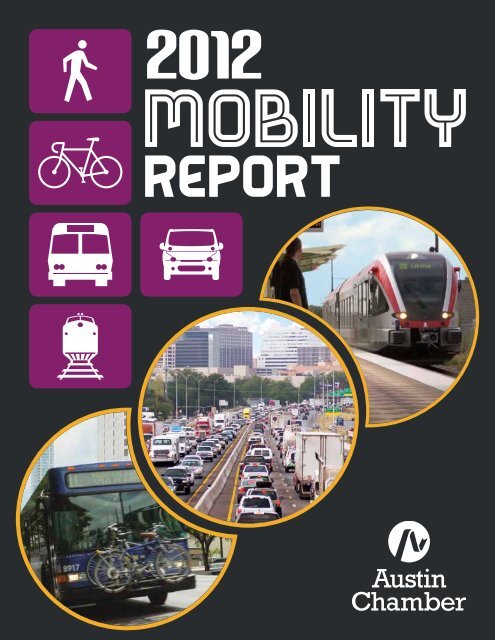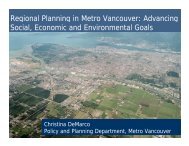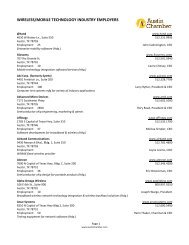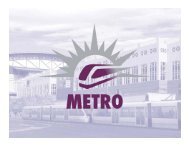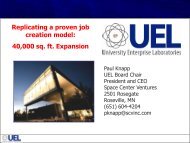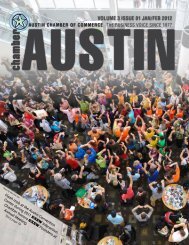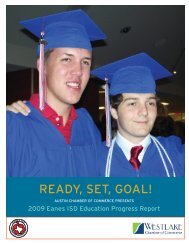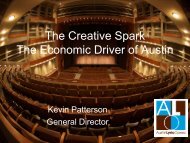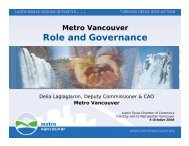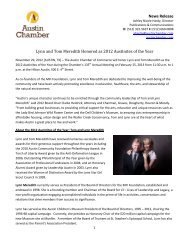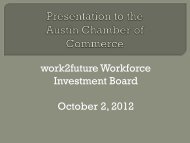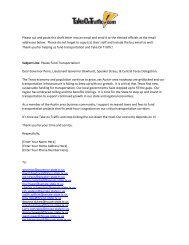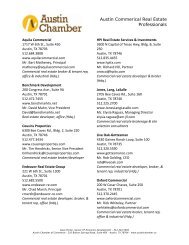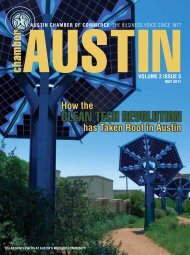1 2012 mobility report - The Greater Austin Chamber of Commerce
1 2012 mobility report - The Greater Austin Chamber of Commerce
1 2012 mobility report - The Greater Austin Chamber of Commerce
You also want an ePaper? Increase the reach of your titles
YUMPU automatically turns print PDFs into web optimized ePapers that Google loves.
<strong>2012</strong> Most Congested Roadway Segments<strong>2012</strong> Rank RoadwayAnnual Delayper Mile (Hours)Annual Cost<strong>of</strong> Congestion($Million)4 IH 35 559,380 110.341 SL 1 165,901 42.950 IH 35 141,904 20.859 IH 35 131,626 25.068 SL 343 114,722 12.281 US 183 104,679 9.495 Slaughter Ln 94,699 8.0Data source: Texas Department <strong>of</strong> Transportation (TxDOT)7
2011 Most Congested Roadway Segments82011 Rank RoadwayAnnual Delayper Mile (Hours)Annual Cost<strong>of</strong> Congestion($Million)4 IH 35 456,928 113.734 US 290 185,055 18.935 SL 1 183,267 53.347 US 183 142,048 15.850 SL 343 128,563 16.352 N Lamar 126,273 18.171 SL 360 106,057 12.972 SL 360 106,037 11.684 US 183 98,916 24.892 FM 734 95,951 8.7Data source: TxDOT
2010 Most Congested Roadway Segments2010 Rank RoadwayAnnual Delayper Mile(Hours)Annual Cost<strong>of</strong> Congestion($Million)4 IH 35 421,778 84.424 N Lamar 195,573 14.539 SL 1 146,130 38.142 SL 360 137,546 3.943 US 290 136,493 11.344 SL 343 135,550 15.357 FM 1325 107,362 5.864 RM 2222 100,936 4.472 RM 2222 95,553 6.280 RM 620 91,940 11.489 SL 360 85,830 6.7Data source: TxDOT9
REGIONAL VISION FOR TRANSITTransit Working Group<strong>The</strong> CAMPO Transit Working Group (TWG) reconvened inNovember 2011 under the leadership <strong>of</strong> <strong>Austin</strong> Mayor LeeLeffingwell. Its charge is to provide input on a high-capacitytransit vision for the five-county <strong>Austin</strong> region includingproject phasing, organizational structure, and funding. <strong>The</strong>CAMPO Regional Transit Map on the following page is thebasis from which the TWG began its work.Project ConnectA complementary public engagement process, ProjectConnect, was underway at the same time and staffedby the same public agencies supporting the TWG. Asidentified by the TWG and the public as a priority transitcorridor, Project Connect is now focusing on transit in theNorth Corridor covering the area from central <strong>Austin</strong> toRound Rock.During the past year, the TWG has wrestled with manyquestions. What priority corridors must be served by highcapacitytransit? What is the appropriate mode: local bus,rapid bus, express lanes, or rail? What are the projectedridership numbers for each <strong>of</strong> the scenarios? How will thepreferred vision be funded for both capital and operations?Technical support for the TWG is provided by CAMPO,Capital Metro, City <strong>of</strong> <strong>Austin</strong>, Lone Star Rail District, andconsultants.METRORAPIDLong supported by the <strong>Austin</strong> <strong>Chamber</strong> through its federaladvocacy initiatives, METRORAPID is closer to operatingtwo routes (North Lamar/South Congress and Burnet/SouthLamar) with increased frequency, fewer stops, and trafficsignal priority. In April <strong>2012</strong>, Federal Transit Administratorpresented Capital Metro with grant funds equal to 80%<strong>of</strong> the rapid bus project costs. <strong>The</strong> <strong>Austin</strong> <strong>Chamber</strong> washonored to participate in the September <strong>2012</strong> groundbreaking ceremony for this public transportation servicescheduled to begin operating in 2014.<strong>The</strong> <strong>Austin</strong> <strong>Chamber</strong> thanks the following communityleaders for their ongoing participation as members <strong>of</strong> thereconvened TWG.<strong>Austin</strong> Mayor Lee Leffingwell, ChairJohn Langmore, Vice ChairRound Rock Mayor Alan McGrawHays County Commissioner Will ConleyTravis County Commissioner Sarah EckhardtBastrop County Commissioner Willie Piña<strong>Austin</strong> Council Member Bill SpelmanSid CovingtonAundre DukesScott FlackJesus GarzaBobby JenkinsJohnny LimonBarry McBeeDarrell PierceMartha SmileyTom Stacy<strong>The</strong> Honorable Ronnie McDonald (former member)Terry Bray (former member)10 REGIONAL VISION FOR TRANSIT
PROGRESS ON MAJOR CORRIDORSMOBILITY INVESTMENT PRIORITIES – RIDER 42As announced by Senator Kirk Watson at the <strong>Austin</strong> <strong>Chamber</strong>’s 2011 State <strong>of</strong> Transportation event, the state <strong>of</strong> Texashas committed to fighting congestion. Through legislation and funding, known as Rider 42, approved during 82ndLegislative Session Central Texas received an allocation <strong>of</strong> $31 million to improve the region’s share <strong>of</strong> the state’s 50most congested segments in 2011.Senator Watson formed a working group that began its work immediately with its first meeting in September 2011. <strong>The</strong>group’s first recommendations gained the approval <strong>of</strong> the Texas Transportation Commission in February <strong>2012</strong> to expandthe scope <strong>of</strong> the IH 35 corridor study begun by the City <strong>of</strong> <strong>Austin</strong> and accelerate the progress <strong>of</strong> the Mopac Phase IIexpress lanes project.<strong>The</strong> working group has continued its work with a greater focus on IH 35. Traffic modeling is underway to evaluate thepotential outcomes <strong>of</strong> various capacity enhancement scenarios; results are expected later this year. <strong>The</strong> <strong>Austin</strong> <strong>Chamber</strong>identified IH 35 as the “elephant in the room” during the 2011 State <strong>of</strong> Transportation event. Improving the corridor willtake many years, but there has been substantive progress in developing an implementation plan in the near future.<strong>The</strong> <strong>Austin</strong> <strong>Chamber</strong> thanks the following community leaders for their ongoing participation as members <strong>of</strong> the CentralTexas Mobility Investment Priorities Working Group.Robert GoodeMike HeiligensteinJohn LangmorePhase 3Phase 4Phase 5ColorsImplementation PlanIdentify issues and constraints; assess project scope, critical components and geometrics;operational assessment; fatal flaw analysis; develop preliminary cost estimates; identify fundingopportunities; public outreachSchematic and Environmental CoordinationPrepare preliminary schematic (30%); determine ROW needs; develop and processenvironmental documentation; public involvement and agency coordinationConstruction Plans, ROW and Utility CoordinationPrepare detailed construction plans; acquire necessary ROW; adjust utilities and preparedetailed cost estimatesLetting and ConstructionFinal approval <strong>of</strong> PS&E; secure funding; release final proposal; advertise request for bids;review bids; award contract and initiate project constructionPhaseCompleteSenator Kirk Watson, ChairGreg MalatekMaureen McCoyTerry MitchellPhaseUnderwayPhaseNot BegunJim PledgerTom StacyCarlos Lopez(former member)Reporting on PRogress -Description <strong>of</strong> PhasesOn the following pages, the <strong>Austin</strong> <strong>Chamber</strong> <strong>report</strong>s on the progress <strong>of</strong> various regional projects using the description <strong>of</strong>phases below as created by the City <strong>of</strong> <strong>Austin</strong>’s IH 35 Corridor Development Study Technical Advisory Committee.Conceptual PlanningPhase 1 Perform high-level concept planning; identify project need and scope; public outreachPhase 212 PROGRESS ON MAJOR CORRIDORS
Improving the System: Reportingon Progress – Mopac CorridorMopacImprovementProject Phase I(Parmer to CesarChavez)Received FONSI (Finding <strong>of</strong>No Significant Impact) fromFHWA (Federal HighwayAdministration) in August<strong>2012</strong>. Construction contractto be considered byCTRMA Board in January2013. Construction to beginSpring 2013. Open 2016.1 2 3 4 5MopacImprovementProject PhaseII (the River toslaughter Lane)Procurement underway forenvironmental services.Funding secured throughPhase 4.1 2 3 4 5Phase 1 Conceptual PlanningPhase 2 Implementation PlanPhase 3 Schematic and EnvironmentalCoordinationPhase 4 Construction Plans, ROW andUtility CoordinationPhase 5 Letting and ConstructionColorsPhaseCompletePhaseUnderwayPhaseNot BegunMopac/US 290 WInterchangeNorthbound from Mopac toEastbound US290 open.Westbound US290 toSouthbound Mopac to openin November.1 2 3 4 5<strong>2012</strong> Mobility Report13
Improving the System:Reporting on Progress – IH 35Gaining MomentumSummer/Fall 2010: Williamson and Hays Counties signpass through agreements with TxDOT to fund multipleprojects along IH 35 corridor.November 2010: <strong>Austin</strong> voters approve Proposition 1 thatincludes $1.0 million for IH 35 Corridor Development StudyMay 2011: Texas Legislature passes Rider 42 whichreserves funding for the top 50 most congested segmentson the state system. IH 35 from US183 to SH 71 is #4.August 2011: Senator Kirk Watson announces Rider 42Working Group at the 2nd Annual State <strong>of</strong> Transportation.Terry Mitchell selected to represent the <strong>Chamber</strong>.December 2011: Direct connects at IH 35 & Ben Whiteopen.February <strong>2012</strong>: Texas Transportation Commissionapproves an additional $1.2 million to expand theboundaries <strong>of</strong> City <strong>of</strong> <strong>Austin</strong> IH 35 Corridor DevelopmentStudy including express lanes from SH 45 on the north toSH 45 on the south.August <strong>2012</strong>: <strong>Austin</strong> City Council places Proposition 12 onthe November ballot. $15.0 million is included for IH 35.August <strong>2012</strong>: Central Texas Rider 42 Working Grouprecommends an additional $10.75 million Rider 42 fundingfor IH 35. TTC will consider in the fall <strong>of</strong> <strong>2012</strong>.September <strong>2012</strong>: CAMPO approves $6.58 million for IH 35projects in Williamson and Hays Counties.Major IH 35 Projects & StudiesShort-term & Mid-term Improvements (SH 130 in Williamson Co. to just South <strong>of</strong> FM 110 in Hays Co.)Numerous studies & projects in various stages. Examples <strong>of</strong> projects are depicted on the map on the following page.Express Lanes (potentially Georgetown to San Marcos)Multiple segments in various phases <strong>of</strong> project development. Funding secured for Phase 1-2 for all segments. No fundingsecured for construction.IH 35 Corridor Development StudyBegun under the leadership <strong>of</strong> the City <strong>of</strong> <strong>Austin</strong> and with funding from the 2010 bond election, this study has beenexpanded based on recommendations from Senator Watson’s Rider 42 Working Group. Working with TxDOT,www.Mobility35.org was launched in September <strong>2012</strong>.Long-Term Vision for IH 35 (Williamson/Bell County line to Hays/Comal County line)CAMPO 2035 Plan does not address long-term vision. Texas Transportation Institute modeling six scenariosthrough Rider 42 effort to guide future policy dialogue and decisions.14 PROGRESS ON MAJOR CORRIDORS
IH 35 Frontage Road Improvements,Westinghouse Road to SH 29: fundedby Williamson County and TxDOT; to letin November <strong>2012</strong>1 2 3 4 5EXAMPLES OF IH 35CORRIDOR PROJECTSIH 35 Ramp Reversal, FM 3406 to US79: funded by Round Rock; currently inPhase 31 2 3 4 5IH 35 (NB) at 51st Street: funded byTxDOT & City <strong>of</strong> <strong>Austin</strong>; currently in Phase3 with construction letting anticipatedAugust 20131 2 3 4 5IH 35 at Oltorf Street: projectdevelopment funded by TxDOT; Phase4 to be complete by fall 2014; noconstruction funds secured*1 2 3 4 5IH 35 at Riverside Drive: projectdevelopment partially funded by TxDOT;no construction funds secured1 2 3 4 5IH 35, FM 1626 to South <strong>of</strong> RM 150:reconstruct southbound frontageroads and convert to one-way; underconstruction1 2 3 4 5IH 35 Stassney Lane – WilliamCannon: project development funded byTxDOT; Phase 4 to be complete by fall2014; no construction funds secured*1 2 3 4 5Phase 1 Conceptual PlanningPhase 2 Implementation PlanPhase 3 Schematic and EnvironmentalCoordinationPhase 4 Construction Plans, ROW andUtility CoordinationPhase 5 Letting and ConstructionColorsPhaseCompletePhaseUnderwayPhaseNot Begun*Improvements may include:u-turn bridges, rampimprovements, additionalintersection approach lanes,auxiliary lanes, sidewalksand other bicycle/pedestrianimprovements.<strong>2012</strong> Mobility Report15
Improving the System:Reporting on Progress -Regional Corridors183A Phase II: Open seven yearsearly!1 2 3 4 5SL 360 Long-term VisionCorridor study and projectdevelopment has not begun. N<strong>of</strong>unding identified.SL 360 Interim IntersectionImprovements Segments 1-3:All worked stopped due toneighborhood opposition.1 2 3 4 5US 290/SH 71 InterimIntersection Improvements(Convict Hill to 1826): Fundedby City <strong>of</strong> <strong>Austin</strong>, Travis Countyand TxDOT. Construction contractto let October/November <strong>2012</strong>.Open late 2013.1 2 3 4 5SL 360 Interim IntersectionImprovements Segment 4(Mopac/Southern end <strong>of</strong>SL360): Neighborhood oppositionlimited project to minor, traditionalintersection improvements. Phases2 – 4 are funded. No constructionfunds secured.1 2 3 4 5Y at Oak Hill Long-termVision: Environmental studiesbegin in November <strong>2012</strong>. Noconstruction funds secured.1 2 3 4 5SH 45 SW: Environmentalstudies to begin in October/November <strong>2012</strong>.1 2 3 4 5SH 45 SWIn May <strong>2012</strong> <strong>Austin</strong> City Council voted to upholdthe Imagine <strong>Austin</strong> Citizen Advisory Task Force’sand Planning Commission’s decision not toinclude SH 45 SW in the Imagine <strong>Austin</strong> Plan.Council also directed staff to file amendments toremove SH 45 SW from the CAMPO 2035 Planand Transportation Improvement Program (TIP).City staff submitted amendments to CAMPO inAugust <strong>2012</strong>. On September 27, <strong>2012</strong> Councildirected staff to withdraw the amendment until alater time when new modeling is available.US 290/SH 71 ContinuousFlow Intersection InterimImprovements (WilliamCannon to Y at Oak Hill):Funded by City <strong>of</strong> <strong>Austin</strong> andTxDOT. Construction contract to letFebruary 2013. Open early 2014.1 2 3 4 516 PROGRESS ON MAJOR CORRIDORS
Phase 1 Conceptual Planning183 (N) Express Lanes Study(RM 620 south to Loop 1):Funding secured for environmentalstudies and a traffic and revenuestudy that will begin in late <strong>2012</strong>1 2 3 4 5Phase 2 Implementation PlanPhase 3 Schematic and EnvironmentalCoordinationPhase 4 Construction Plans, ROW andUtility CoordinationPhase 5 Letting and ConstructionColorsPhaseCompletePhaseUnderwayPhaseNot BegunUS 290 East (ManorExpressway) Phase I: US183/US290 interchange underconstruction. To open late <strong>2012</strong>.1 2 3 4 5US 290 East (ManorExpressway) Phase II: Underconstruction. Entire project toopen 2014.1 2 3 4 5Bergstrom Expressway(183 from US 290 to SH 71):Environmental studies to becomplete summer <strong>of</strong> 2014.1 2 3 4 5SH 71 at 973: Superstreetconstruction underway. To openJanuary 2013.1 2 3 4 5SH 71/Riverside Overpass:Under construction. To open 2014.1 2 3 4 5SH 130 Segments 5 and 6:Under construction. To openNovember <strong>2012</strong>.1 2 3 4 5<strong>2012</strong> Mobility Report17
Research: Process and Analysis2011 Commuter Congestion ResearchAs stated earlier in this <strong>report</strong>, “Central Texas businessleaders agree: the greatest impediment to the region’sprosperity is traffic.” This comment summarizes findingsfrom the Market Street Services consulting teamengaged to recommend the next five-year Opportunity<strong>Austin</strong> economic development strategy.Peak congestion impacts all Central Texans, butparticularly its workers. As seen on page 4, afternooneveningrush hours have the highest amounts <strong>of</strong>delay compared to any other time <strong>of</strong> the day. Ratherthan spending time at home or engaging in othermeaningful activities, Central Texans suffer throughpeak congestion at the end <strong>of</strong> the work day. As thevoice <strong>of</strong> business for Central Texas, the <strong>Austin</strong> <strong>Chamber</strong>last year sought to present data on traffic from anemployer’s perspective. Where are the jobs in CentralTexas located? Where do the workers live that holdthose jobs?Using 2009 data sets from the US Census Bureau[Longitudinal Employer-Household Dynamics (LEHD)and Local Employment Dynamics (LED): http://lehdmap.did.census.gov/] the <strong>Chamber</strong> created mapsfor major employment areas showing where workerslive by zip code.Released at the 2011 State <strong>of</strong> Transportation event, themap on this page depicts the concentration <strong>of</strong> wherecentral <strong>Austin</strong> workers live. Defined by the zip codes<strong>of</strong> 78701, 78703, 78704, and 78705, central <strong>Austin</strong>contained major employment destinations including thecentral business district, the state capitol complex, andthe University <strong>of</strong> Texas at <strong>Austin</strong>. Of the jobs containedin those four zip codes, approximately 90% <strong>of</strong> theworkers <strong>report</strong>ed residences outside <strong>of</strong> the same area.Revised REsearch ApproachWith the release <strong>of</strong> the updated 2010 LEHD and LEDdata along with the <strong>of</strong>ficial decennial census data,the <strong>Chamber</strong> began the process <strong>of</strong> updating theresearch maps. In updating and improving methods,the geographic focus was refined. Zip code sizes varywidely and cover large areas. To address disparitiesin shape and size and more closely understand finerlevels <strong>of</strong> detail, the <strong>Chamber</strong> research team employed agrid system to present data in a more uniform manner.Grid blocks are ½ mile per side and ¼ square milein area. With a consistent geographic scale, areas <strong>of</strong>concentration may be better depicted.18RESEARCH MAPS
<strong>2012</strong> Commuter Congestion Research<strong>The</strong> map on this page illustrates the updated data setsimilar to the previous year for where central <strong>Austin</strong>workers live. <strong>The</strong> full map “Where do central coreemployees live?” may be seen on page 22. By usingthe grid system, a zip code whose population includesboth dense and rural characteristics would no longer beshown in a uniform manner. With their uniform size, thegrids display concentration and scale more consistently.<strong>The</strong> “Where do Central Texans live?” map on page 20depicts regional population data from the 2010 Census.<strong>The</strong> “Where are Central Texas jobs located?” map onpage 21 depicts employment locations gathered fromthe 2010 LEHD data set. <strong>The</strong> finer level <strong>of</strong> geographyreveals anomalies in data <strong>report</strong>ing that must be takeninto account, for example <strong>report</strong>ing post <strong>of</strong>fice boxesas either a residence or a job location. Nevertheless,the maps provided an illustration <strong>of</strong> the relationshipsbetween work and home.<strong>The</strong> final map “Where are jobs and residentsconcentrated?” on page 23 intends to show overlappingdensities: jobs plus population. As drawn from theirpolicy brief, Mass Transit & Mass: Densities Neededto Make Transit Investments Pay Off and their full<strong>report</strong> Cost <strong>of</strong> a Ride: <strong>The</strong> Effects <strong>of</strong> Densities onFixed-Guideway Transit Ridership and Capital Costs,Erick Guerra and Robert Cervero <strong>of</strong> the University <strong>of</strong>California, Berkeley state “mass transit” needs “mass”—i.e., “density.” This map is by no means the result <strong>of</strong>exhaustive research or a full examination <strong>of</strong> academicliterature available, but it aids in refining the discussion<strong>of</strong> a regional vision for transit.Academic Literature ReferencesMass Transit & Mass: Densities Needed to MakeTransit Investments Pay Off by Erick Guerra and RobertCervero <strong>of</strong> the University <strong>of</strong> California, Berkeleywww.uctc.net/research/briefs/UCTC-PB-2011-02.pdfCost <strong>of</strong> a Ride: <strong>The</strong> Effects <strong>of</strong> Densities on Fixed-Guideway Transit Ridership and Capital Costs byErick Guerra and Robert Cervero <strong>of</strong> the University <strong>of</strong>California, Berkeleywww.uctc.net/research/papers/UCTC-FR-2010-32.pdf<strong>2012</strong> Mobility Report19
Where Are Central Texas Jobs Located?<strong>2012</strong> Mobility Report21
Where do central core employees live?22RESEARCH MAPS
<strong>2012</strong> Mobility Report 23Where are jobs and residents concentrated?
535 East 5th Street<strong>Austin</strong>, Texas 7870124Research Maps


